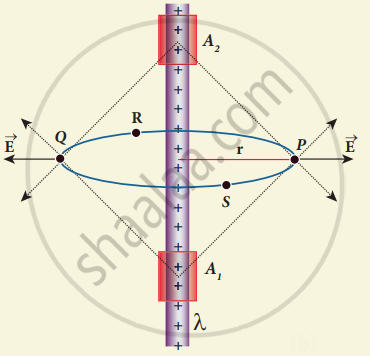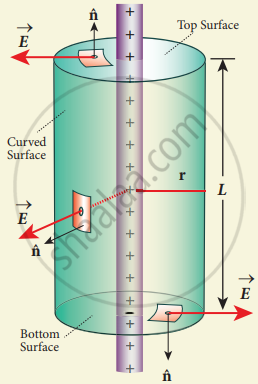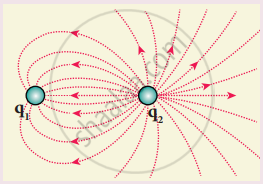Advertisements
Advertisements
Question
Obtain the expression for electric field due to an infinitely long charged wire.
Solution
Consider an infinitely long straight wire having uniform linear charge density λ. Let P be a point located at a perpendicular distance r from the wire. The electric field at the point P can be found using Gauss law. We choose two small charge elements A1 and A1 on the wire which are at equal distances from the point P.
The resultant electric field due to these two charge elements points radially away from the charged wire and the magnitude of electric field is same at all points on the circle of radius r. From this property, we can infer that the charged wire possesses a cylindrical symmetry.
(a)

(b)

Electric field due to infinite long charged wire
Let us choose a cylindrical Gaussian surface of radius r and length L. The total electric flux in this closed surface is
ΦE = `oint vec"E" * "d"vec"A"` ....(1)
ΦE = `int_"Curved surface" vec"E"*"d" vec"A" + int_"Top surface" vec"E"*"d"vec"A" + int_"Bottom surface" vec"E"*"d"vec"A"` ...(2)
It is seen that for the curved surface, `vec"E"` is parallel to `vec"A" and vec"E"*"d" vec"A" = "EdA"`. For the top and bottom surface, `vec"E"` is perpendicular to `vec"A" and vec"E"*"d"vec"A" = 0`
Substituting these values in equation (2) and applying Gauss law

Cylindrical Gaussian surface
ΦE = `int_"Curved surface" "EdA" = ("Q"_"encl")/ε_0` .....(3)
Since the magnitude of the electric field for the entire curved surface is constant, E is taken out of the integration and Qencl is given by Qencl = λL.
`"E" int_"Curved surface" "dA" = (λ"L")/ε_0` ....(4)
Here,
ΦE = `int_"Curved surface"`dA
dA = total area of the curved surface = 2πrL. Substituting this in equation (4), We get
`"E"*2pi"rL" = (lambda"L")/ε_0` (or) E = `1/(2piε_0) lambda/"r"` .....(5)
In vector from, `vec"E" = 1/(2piε_0) lambda/"r" hat"r"` ......(6)
The electric field due to the infinite charged wire depends on `1/"r"` rather than `1/"r"^2` for a point charge.
Equation (6) indicates that the electric field is always along the perpendicular direction `(hat"r")` to wire. In fact, if λ > 0 then E points perpendicular outward `(hat"r")` from the wire and if λ < 0, then E points perpendicular inward `(-hat"r")`.
APPEARS IN
RELATED QUESTIONS
What is the ratio of the charges `|"q"_1/"q"_2|` for the following electric field line pattern?

Define ‘electric field’.
What is mean by ‘electric field lines’?
The electric field lines never intersect. Justify
Discuss various aspects of the electric field.
Obtain the expression for electric field due to an charged infinite plane sheet.
Obtain the expression for electric field due to an uniformly charged spherical shell.
